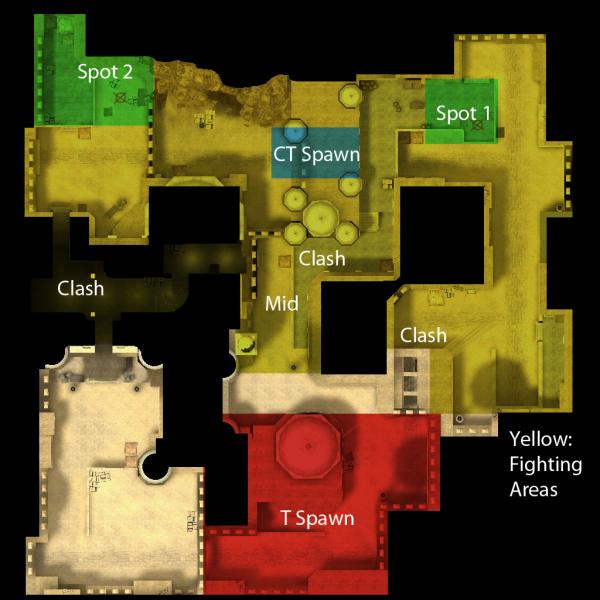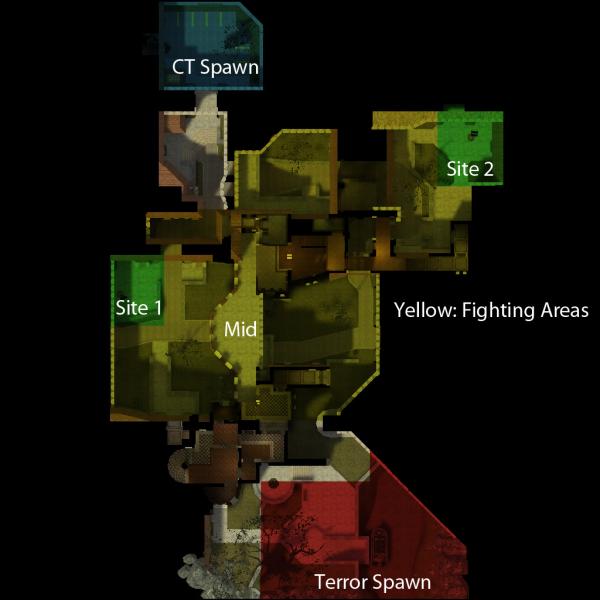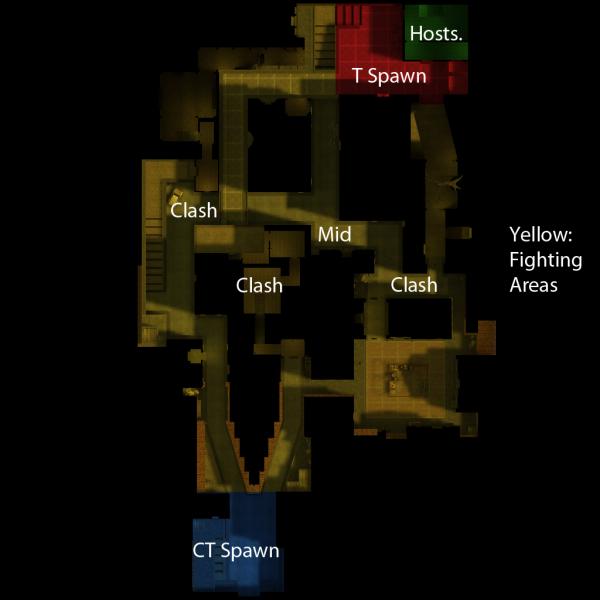Tutorial: Map Layout Theory for CS Last edited 5 years ago2019-04-23 07:50:55 UTC
You are viewing an older revision of this wiki page. The current revision may be more detailed and up-to-date.
Click here to see the current revision of this page.
When creating a counter-strike map there are several things you need to consider in order to achieve good gameplay.
First, lets take a look at some successful maps.In de_dust2 there are two bomb spots on both sides of the CT spawn, allowing them to choose in which direction to go. It is the same for the T's however it takes them longer to reach the objective, allowing the CT's to set up their defenses / camping locations.
The map has three Clash points, a clash point is an area where both teams are most likely to run into each other, these are areas where most firefights will take place.
There is also a Mid point in the map which can be used to switch between bomb spots or provide support from different angles.
de_dust2 is such a successful map because it allows for fast paced gameplay throughout. The terrorists always have three routes to choose from, and they can always switch around thanks to the mid point. The Clash areas are well balanced, both teams have an equal amount of space and cover.
There are other successful maps that use the exact same theory as de_dust2, like Piranesi.The layout is slightly more complex, but the theory remains the same. There are two sites that the CT's reach first, the T's have three main routes to choose from, and they are able to mix things up thanks to the mid point of the map. Piranesi is also great because both teams have the ability to provide support for the bomb spot from atop or inside the castle.
Hostage rescue maps are slightly different. Italy is a good example of a successful hostage rescue map.Again as you can see, the theory is nearly the same. There are three big clash points where the teams usually meet, just like in de_dust2. You are also able to quickly switch sides thanks to the mid point in the map.
It is quite big in size, It can prove to be a nuisance sometimes if playing with less than 12 players, but that's what it's designed for, for big 24-32 player servers.
The only difference in this map to dust2, is that there is only one objective; the hostage rescue point, and that is behind the terrorist spawn. But even though there is only one objective, the map balances itself out by adding three entrances to the terrorist spawn, if there was only one entrance for example it would be nearly impossible to rescue the hostages.
cs_italy and cs_office are both good examples of successful hostage rescue maps.
As you can see from above, almost all successful maps have a similar layout where there are three passages to choose from and a mid point you can use to switch between passages. This is the sole reason why these few maps are so successful compared to others, this method is very good for strategic and fast paced gameplay.
To solve these problems you will have to play test your map before you release it. Play testing your map will help you solve small issues you may have not expected or seen while creating your map.
- Where will both teams clash?
- How fast does each team reach their objective(s)?
- How close are both bomb sites / hostages?
Bomb and Rescue maps
I'd like to start the tutorial by introducing you to some good ways to layout your cs_ and de_ maps.First, lets take a look at some successful maps.In de_dust2 there are two bomb spots on both sides of the CT spawn, allowing them to choose in which direction to go. It is the same for the T's however it takes them longer to reach the objective, allowing the CT's to set up their defenses / camping locations.
The map has three Clash points, a clash point is an area where both teams are most likely to run into each other, these are areas where most firefights will take place.
There is also a Mid point in the map which can be used to switch between bomb spots or provide support from different angles.
de_dust2 is such a successful map because it allows for fast paced gameplay throughout. The terrorists always have three routes to choose from, and they can always switch around thanks to the mid point. The Clash areas are well balanced, both teams have an equal amount of space and cover.
There are other successful maps that use the exact same theory as de_dust2, like Piranesi.The layout is slightly more complex, but the theory remains the same. There are two sites that the CT's reach first, the T's have three main routes to choose from, and they are able to mix things up thanks to the mid point of the map. Piranesi is also great because both teams have the ability to provide support for the bomb spot from atop or inside the castle.
Hostage rescue maps are slightly different. Italy is a good example of a successful hostage rescue map.Again as you can see, the theory is nearly the same. There are three big clash points where the teams usually meet, just like in de_dust2. You are also able to quickly switch sides thanks to the mid point in the map.
It is quite big in size, It can prove to be a nuisance sometimes if playing with less than 12 players, but that's what it's designed for, for big 24-32 player servers.
The only difference in this map to dust2, is that there is only one objective; the hostage rescue point, and that is behind the terrorist spawn. But even though there is only one objective, the map balances itself out by adding three entrances to the terrorist spawn, if there was only one entrance for example it would be nearly impossible to rescue the hostages.
cs_italy and cs_office are both good examples of successful hostage rescue maps.
As you can see from above, almost all successful maps have a similar layout where there are three passages to choose from and a mid point you can use to switch between passages. This is the sole reason why these few maps are so successful compared to others, this method is very good for strategic and fast paced gameplay.
Where to start?
When creating a map, it would be best to first create a layout / overview clearly showing all the paths, objectives and clash points. Making sure early on that your map is laid out properly is important.What should I do while creating my map?
- First of all find out where the teams will clash. Make sure there is an equal amount of cover when entering from both sides. For example; If the T's have ten boxes to hide behind as they enter the area, but the CT's have none, the area is very unbalanced as the T's will most likely kill all the CT's thanks to all the cover they have.
- Second, make sure there is a Middle in your map, which the players can use to switch between paths / objectives. Middles are very important gameplay wise as they allow players to flank the enemy team, or retreat. They are the basis for strategic gameplay.
- Third, make sure the defenders are closer to the objective than the attackers. This isn't necessary, but if the T's reach the bomb spot and plant the bomb before the CT's can get near it, well then you have a problem there.
- Fourth, keep in mind the size of your map. If it takes too long for players to reach their objectives, the pace of the game will slow down. If you look at maps like piranesi, dust, office; the attacking team can get to their objectives within a time window as small as 10 seconds. Even though the maps are quite large, both teams reach their objectives quite quickly, and that allows for fast paced gameplay. Nobody wants to run for 30 seconds to their objective, only to get sniped instantly, that would be a waste.
- Finally, Keep in mind that there are some overpowered weapons in counter-strike like the AWP and the shotgun. All players have their own play-style, some choose pistols or sub-machine guns, some choose rifles or shotguns. It is important that you take these weapons in consideration. Making several long corridors will simply favor the awp over all other weapons, but making the map really cramped together would overpower the shotgun. I'm not saying it is bad to have many awp areas, however you have to take in consideration how annoying they can get. de_dust 2 is good because even though it has quite a few open areas, it has plenty of cover to hide behind.
The pre-release process
Just because your map is layed out nicely wont always mean that gameplay will be good. There can still be some unbalanced areas where one team has an advantage over another, There can be overpowered sniper spots, or areas too close together making long range weapons nearly useless.To solve these problems you will have to play test your map before you release it. Play testing your map will help you solve small issues you may have not expected or seen while creating your map.
Small arena or skill maps
Arena maps like fy_, 35hp_, aim_, gg_, awp_ are a completely different deal. Usually very small maps, having no strategic gameplay what so ever. Still, there are some things you can keep in mind to make the maps just a bit better:- Make sure the players can't see each other as they've spawned (For gun maps only). Many bad maps have this problem, many players instantly die as the round starts.
- (Knife Maps) Make sure there is more than one path for the players to choose from, if there is only one, this can result in the problem where players refuse to move forwards and slow down the pace of the game.
- Weapon placements, make sure one team doesn't get the good guns and another gets the bad ones.
- Turn the buyzones off. Usually small maps have guns lying around on the floor, this is ok, but turn the buyzones off if that's the case.
- Categories
- Tutorials
- Intermediate Tutorials
- General Tutorials
9 Comments
You must log in to post a comment. You can login or register a new account.




Too many may cause unbalanced gameplay and confusion among players.
Also, some of the very best maps have places out side and inside buildings, like de_nuke that has a below level, big yard and a building.
Combining these things can result into a great map that is fun to play and has quick game paste.